समतापी प्रक्रम की प्रारम्भिक स्थित (P1,V1,T1) अन्तिम स्थित (P2,V2,T2) तक परिवर्तित होती है यदि यह परिवर्तन एक मोल आदर्श गैस के लिए हो तो एट्रांपी परिवर्तन होगी
शून्य
R In T
RInV1V2
RInV2V1
The correct Answer is:C
आदर्श गैस में एंट्रापी परिवर्तन
ΔS=ΔQT ….(i)
समतापी प्रक्रम में ताप नियत रहता है तथा ऊर्जा भी नियत होगी इसलिए आंतरिक उर्जा में परिवर्तन ΔU=0
ऊष्मा गतिकी के प्रथम नियमानुसार
ΔU=ΔQ−W⇒0=ΔQ−W⇒ΔQ=W
अतः ΔQ = समतापी प्रक्रम में गैस द्वारा किया गया कार्य प्रक्रम के अनुसार (P1V1,T) में (P2,V2,T) तक
⇒ΔQ=−μRTloge(V2V1) ..(ii)
आदर्श गैस के 1 मोल के लिए (μ=1) समीकरण (i) और (ii) से ΔS=Rloge(V2V1)=RIn(V1V2)
Topper's Solved these Questions
- ऊष्मागतिक प्रक्रम Book:ERRORLESS HINDIChapter:ऊष्मागतिक प्रक्रम Exercise:CRITICAL THINKING
Explore 39 Videos
- ऊष्मागतिक प्रक्रम Book:ERRORLESS HINDIChapter:ऊष्मागतिक प्रक्रम Exercise:GRAPHICAL QUESTIONS (OBJECTIVE QUESTIONS)
Explore 37 Videos
- ऊष्मागतिक प्रक्रम Book:ERRORLESS HINDIChapter:ऊष्मागतिक प्रक्रम Exercise:Ordinary Thinking Objective Questions (समदाबीय एवं समआयतनिक प्रक्रम)
Explore 20 Videos
- ऊष्मा संचरण Book:ERRORLESS HINDIChapter:ऊष्मा संचरण Exercise:Self Evaluation Test (ऊष्मा संचरण)
Explore 19 Videos
- एक विमीय गति Book:ERRORLESS HINDIChapter:एक विमीय गति Exercise:SELF EVALUATION TEST
Explore 23 Videos
Similar Questions
नियत दाब पर जब आदर्श द्विपरमाणविक गैस को गर्म किया जाता है तो ऊर्जा का वह भाग जो आन्तरिक ऊर्जा वृद्धि में प्रयुक्त होता है, कुल ऊर्जा का है
View Solutionकिसी गैस की अवस्था A से B तक चित्रानुसार प्रक्रम I तथा II के अनुसार परिवर्तित होती है तो आन्तरिक ऊर्जा में परिवर्तन क्रमशः ΔU1 तथा ΔU2 है तब
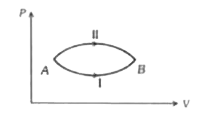
View Solutionसमआयतनिक प्रक्रम के लिए निम्न में से कौनसा सम्बन्ध सही है
View Solutionजल एवं तारपीन तेल (जल से कम विशिष्ट ऊष्मा दोनों को समान ताप तक गर्म किया जाता है। अब दोनों की समान मात्रा को दो सर्वसम कैलोरीमीटरों में अलग-अलग लेकर वायु में रख दिया गया है, तब
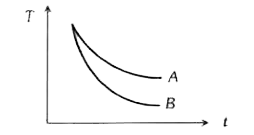
View Solutionएक कण ऊर्ध्वाधर ऊपर की ओर प्रारम्भिक वेग u से फेंका जाता है। T सैकण्ड के अन्तराल के बाद एक अन्य कण उतने ही वेग u से ऊर्ध्वाधर ऊपर की ओर फेंका जाता है, तो
View SolutionFor an ideal gas, an illustratio of three different paths A(B+C) and (D+E) from an initial state P1,V1,T1 to a final state P2,V2,T1 is shown in the given figure.

Path Arepresents a reversible isothermal expansion form P1,V1 to P2,V2, Path (B+C) represents a reversible adiabatic expansion (B) from P1,V1,T1→P3,V2,T2 followed by reversible heating the gas at constant volume (C)from P3,V2,T2 to P2,V2,T1. Path (D+E) represents a reversible expansion at constant pressure P1(D) from P1,V1,T1 to P1,V2,T3 followed by a reversible cooling at constant volume V2(E) from P1,V2,T3→P2,V2,T1.
What is qrev, for path (A)?
View SolutionFor an ideal gas, an illustratio of three different paths A(B+C) and (D+E) from an initial state P_(1), V_(1), T_(1) to a final state P_(2), V_(2),T_(1) is shown in the given figure. Path A represents a reversible isothermal expansion form P_(1),V_(1) to P_(2),V_(2) , Path (B+C) represents a reversible adiabatic expansion (B) from P_(1),V_(1),T_(1)to P_(3),V_(2),T_(2) followed by reversible heating the gas at constant volume (C) from P_(3),V_(2),T_(2) to P_(2),V_(2),T_(1) . Path (D+E) represents a reversible expansion at constant pressure P_(1)(D) from P_(1),V_(1),T_(1) to P_(1),V_(2),T_(3) followed by a reversible cooling at constant volume V_(2)(E) from P_(1),V_(2),T_(3) to P_(2),V_(2),T_(1) . What is q_(rev) , for path (B +C) ?
View SolutionFor an ideal gas, an illustratio of three different paths A(B+C) and (D+E) from an initial state P1,V1,T1 to a final state P2,V2,T1 is shown in the given figure.
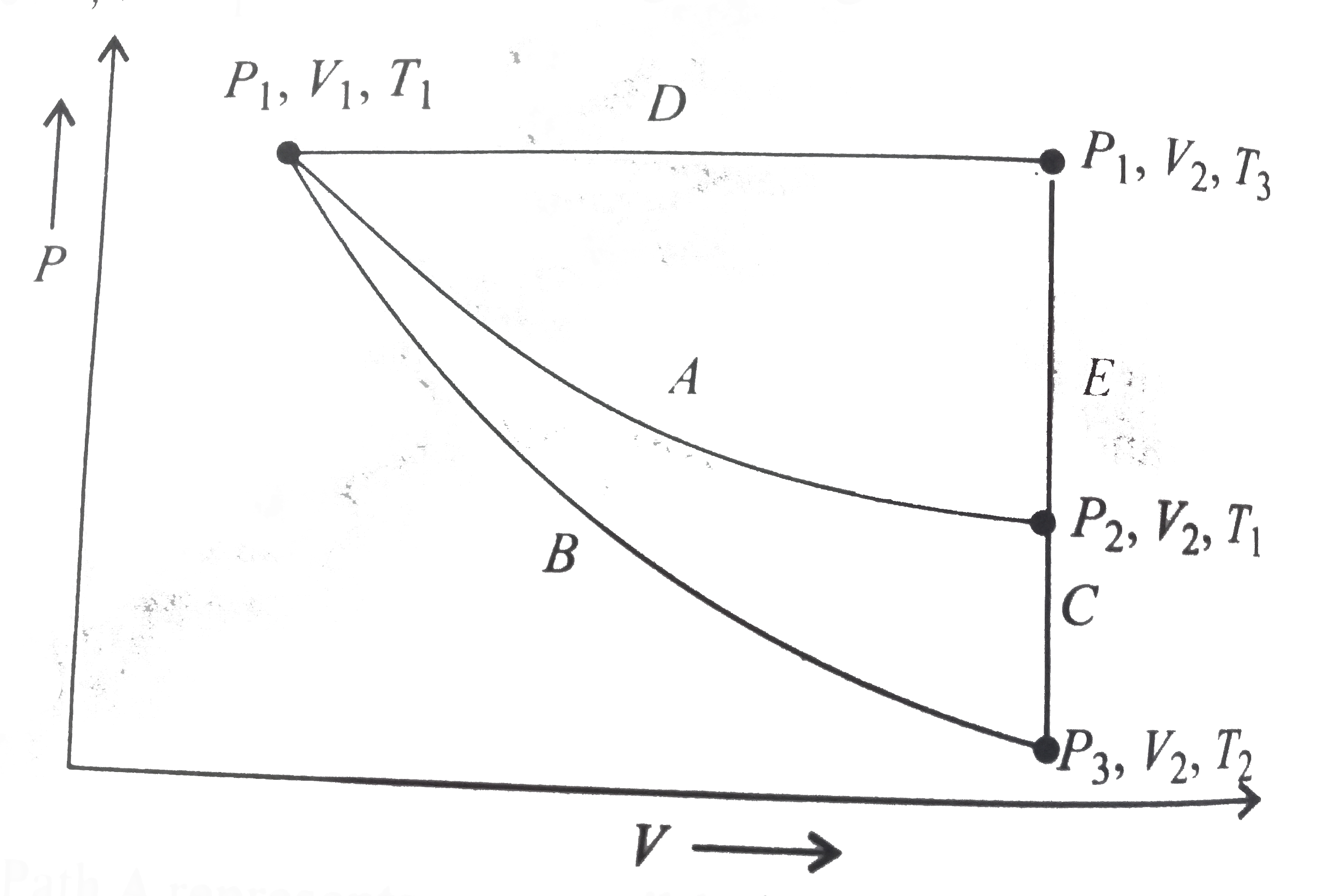
Path Arepresents a reversible isothermal expansion form P1,V1 to P2,V2, Path (B+C) represents a reversible adiabatic expansion (B) from P1,V1,T1→P3,V2,T2 followed by reversible heating the gas at constant volume (C)from P3,V2,T2 to P2,V2,T1. Path (D+E) represents a reversible expansion at constant pressure P1(D) from P1,V1,T1 to P1,V2,T3 followed by a reversible cooling at constant volume V2(E) from P1,V2,T3→P2,V2,T1.
What is ΔS for path A?
View SolutionFor an ideal gas, an illustratio of three different paths A(B+C) and (D+E) from an initial state P1,V1,T1 to a final state P2,V2,T1 is shown in the given figure.
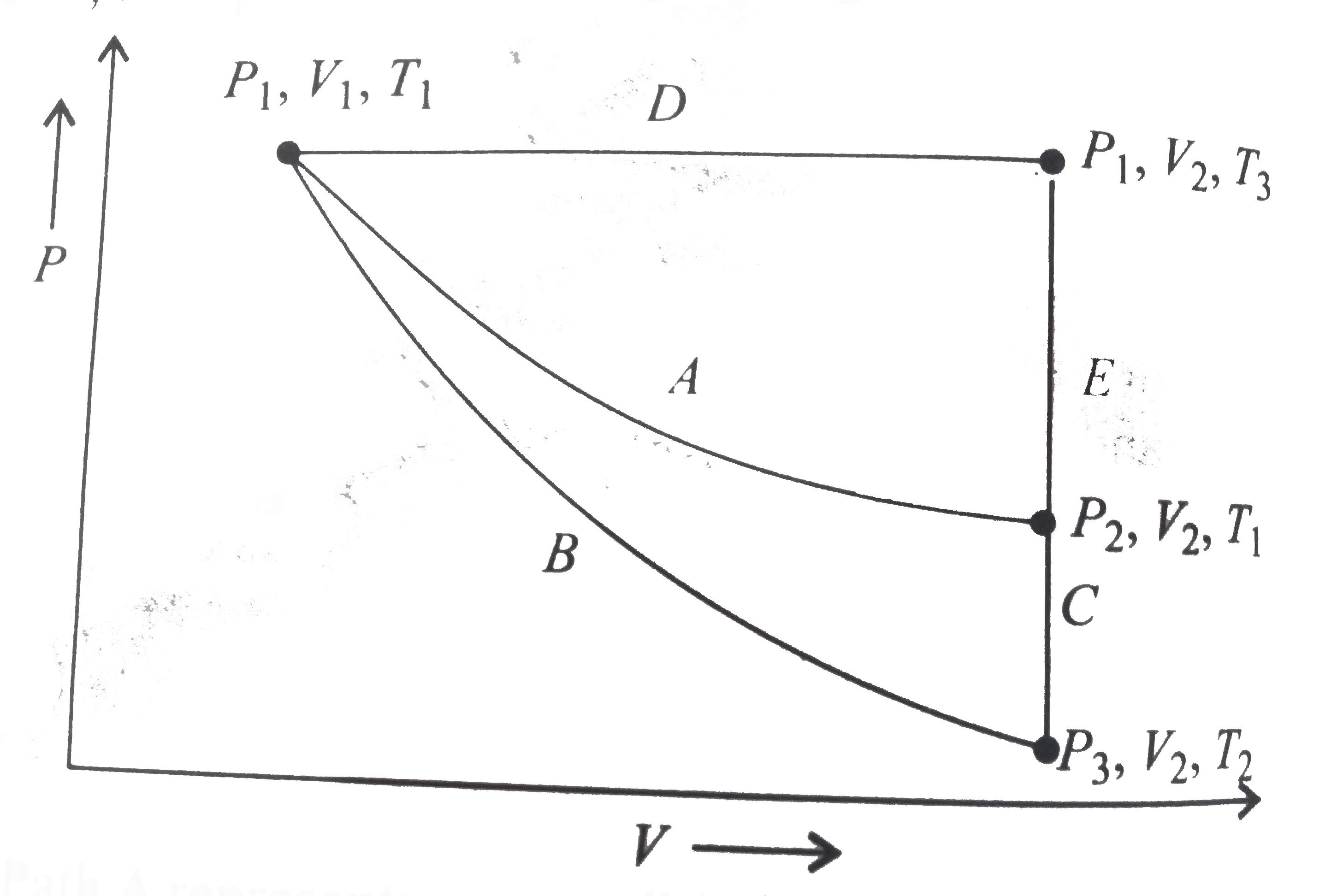
Path Arepresents a reversible isothermal expansion form P1,V1 to P2,V2, Path (B+C) represents a reversible adiabatic expansion (B) from P1,V1,T1→P3,V2,T2 followed by reversible heating the gas at constant volume (C)from P3,V2,T2 to P2,V2,T1. Path (D+E) represents a reversible expansion at constant pressure P1(D) from P1,V1,T1 to P1,V2,T3 followed by a reversible cooling at constant volume V2(E) from P1,V2,T3→P2,V2,T1.
What is qrev, for path (D+E)?
View SolutionAn ideal gasa undergoes through folowing cyclic procees. 1-2 : Reversible adialbatic comparession from P_(1)V_(1)T_(1)"to"P_(2)V_(2)T_(2) 2-3 : Reversible isochoric heating from P_(2)V_(2)T_(2)" to " P_(3)V_(3)T_(3) 3-4 Reversible adialbatic expansion from P_(3)V_(3)T_(3)" to " P_(4)V_(4)T_(4) 4-1 Reversible isochoric cooling from P_(4)V_(4)T_(4)" to " P_(1)V_(1)T_(1) Eefficiencyof the cycle is :
View SolutionFor an ideal monoatomic gas, an illustration of three different paths A,(B+C) and (D+E) from an initial state P_(1),V_(1),T_(1) to a final state P_(2),V_(2),T_(1) is shown in the given figure . Path A represents a reversible isothermal from P_(1)V_(1)" to "P_(2),V_(2) , path (B+C) represent a reversible adiabatic expansion (B) from P_(1),V_(1),T_(1)" to " P_(3),V_(2),T_(2) followed by reversible heating of the gas at constant volume (C) from P_(3),V_(2),T_(2) " to " P_(2),V_(2),T_(1) . Path (D+E) represents a reversible expansion at constant pressure P_(1)(D) from P_(1),V_(1),T_(1) " to "P_(1),V_(2),T_(3) followed by a reversible cooling at constant volume V_(2)(E) form P_(1),V_(2),T_(3) " to "P_(2),V_(2),T_(1) What is q_("rev") for path (A)?
View SolutionFor an ideal monoatomic gas, an illustration of three different paths A,(B+C) and (D+E) from an initial state P1,V1,T1 to a final state P2,V2,T1 is shown in the given figure .
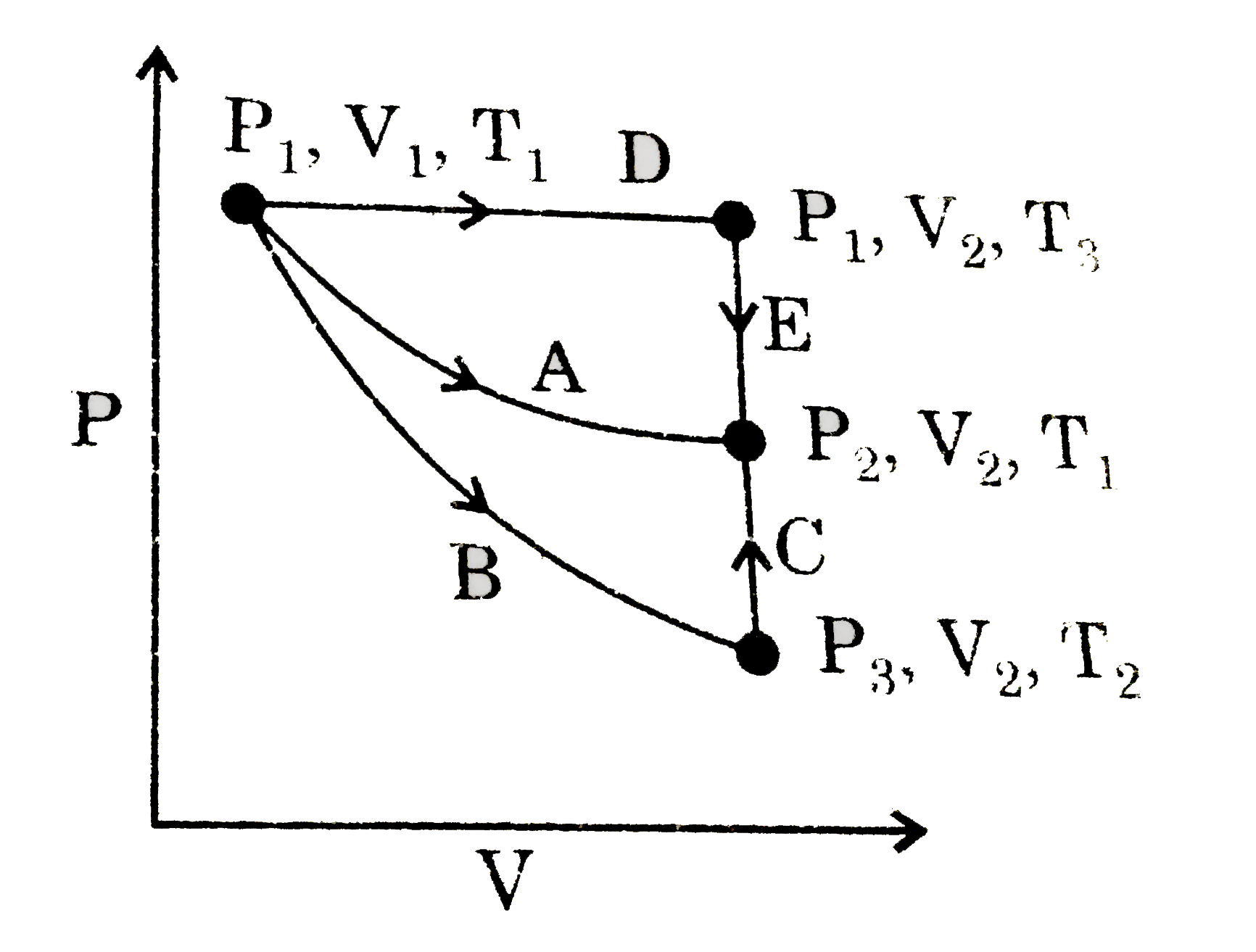
Path A represents a reversible isothermal from P1V1 to P2,V2, path (B+C) represent a reversible adiabatic expansion (B) from P1,V1,T1 to P3,V2,T2 followed by reversible heating of the gas at constant volume (C) from P3,V2,T2 to P2,V2,T1. Path (D+E) represents a reversible expansion at constant pressure P1(D) from P1,V1,T1 to P1,V2,T3 followed by a reversible cooling at constant volume V2(E) form P1,V2,T3 to P2,V2,T1
What is ΔS for (D+E)?
View SolutionExamine the following plots and predict whether in (i) P_(1) lt P_(2) "and" T_(1) gt T_(2) , in (ii) T_(1) = T_(2)ltT_(3) , in (iii) V_(1) gt V_(2), "in" (iv) P_(1) gt P_(2) "or" P_(2) gt P_(1)
View SolutionEstablish gas equation, (P_(1)V_(1))/(T_(1))=(P_(2)V_(2))/(T_(2)) .
View SolutionA system Xundergoes following changes
XP1V1T1→WP2V2T1→ZP3V2T2→XP1V1T1
The overall process may be called as
View SolutionA sample of gas changes from p1,V1 and p2. V2andT2 by one path and then back to p1,V1andT1. ΔU for the process is :
View Solution
